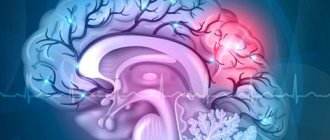Antidepressants
The most important role in the process of drug treatment of depression is played by antidepressants - drugs that systemically improve the patient’s condition, relieving symptoms of depression: emotional disorders, motor and cognitive disorders (memory, attention, thinking), as well as somatic and autonomic manifestations of depression.
Antidepressants can also be effective in the treatment of anxiety, eating disorders, obsessive disorders, vegetative crises, and in eliminating pain of various origins, for example, rheumatism, since antidepressants usually increase the threshold of pain sensitivity.
| Find out more: Types of depression |
The choice of antidepressant for the treatment of depression is primarily determined by the clinical picture of the disease, although it should be kept in mind that those antidepressants that have been effective in the past or have successfully helped family members of the patient are likely to be most useful. Often, selecting an antidepressant that is adequate to the patient’s condition can take quite a long time and on average takes two to three weeks; if the dosage is adjusted, this period can increase to six to eight weeks. Patience is required from both the doctor and the patient, both in terms of the timing of the expected effect and reasonable tactics in case of side effects. Usually the latter occur in the first days of therapy, and their severity can be reduced by changing the dose of the drug or prescribing correctors.
Basic criteria for choosing an antidepressant:
- Clinical picture of depression based on the leading modality of affect
- Effectiveness of an antidepressant in relieving past episodes of depression
- The effectiveness of an antidepressant in relieving depression in close relatives of the patient
- Minimal side effects, tolerance to specific side effects
- No somatic contraindications
- Results of hormonal, neurophysiological, pathopsychological and neuropsychological studies
- Economic feasibility
- Balanced effects on the serotonergic and noradrenergic neurotransmitter systems
- Patient's age
- No negative interactions with other medications used to treat the patient
In practice, the main difficulties in using antidepressants are that their dose is not insufficient in patients with severe depression and not too high in patients with questionable and mild depression (Bochner F., et al., 2000).
The effect of an antidepressant usually appears 2 weeks after its administration, but a more pronounced therapeutic effect may require 6 weeks or more.
In more than a third of patients suffering from depression, the main reason for stopping taking antidepressants and, therefore, an important factor contributing to the formation of stable chronic depression are side effects that develop during the first stage of taking antidepressants. Among the side effects that are the most common reasons for stopping therapy are usually: constant feeling of nausea, weight gain, palpitations, drowsiness or insomnia, sexual disorders, weakness, headache. Often, a person suffering from depression agrees to treatment only with an antidepressant that has a minimum number of side effects. Such tactics for treating depression are usually ineffective.
The main reasons for stopping taking an antidepressant are:
- Side effects of therapy, especially gastrointestinal (nausea, vomiting, flatulence, etc.), cardiological (palpitations, arrhythmias, orthostatic hypotension, etc.), neurological (headache, tremor, sweating, etc.) endocrinological (weight gain, changes in the menstrual cycle etc.), manifestations of sexual dysfunction.
- Decrease in the patient’s quality of life due to taking an antidepressant (the need for long-term use of the drug, its high cost, refusal to drink alcohol, etc.).
- Lack of rapid therapeutic effect of the drug, its inadequate dosage.
- Concerns regarding the development of dependence with long-term use of the drug.
- Negative interaction with other medications (tranquilizers, antipsychotics, cardiovascular drugs, etc.).
- Temporary improvement in the patient's condition.
- There is no information about the required duration of antidepressant therapy, including the stage of long-term maintenance therapy and therapy aimed at preventing relapse of depression.
- Negative suggestibility of the patient regarding the occurrence of possible side effects of the drug (annotations on the drugs, opinions of other patients, close relatives, etc.).
- Belief in one's own strength to combat depression, psychologization of depression, orthodox religiosity, or belief in the effectiveness of psychotherapy.
- Adherence to alternative methods of therapy (non-traditional therapy).
In cases of a negative result, the doctor may increase the dose of the drug, and it should be remembered that the most common mistakes in the treatment of depression are treatment with low doses of an antidepressant and its rapid discontinuation after the patient’s condition improves.
For treatment-resistant depression, a psychiatrist may replace one antidepressant with another, use a combination of them, intensify psychotherapeutic intervention, or use another biological treatment method, such as electroconvulsive therapy. In the case of particularly resistant conditions, clarification of the diagnosis and active treatment of concomitant diseases are required: cardiovascular, gastroenterological, endocrine, etc. Particular caution during antidepressant therapy should be exercised in the presence of pregnancy, liver disease, kidney disease, or indications of cardiovascular disorders. It is important to emphasize that antidepressants are not always combined with the medications that are used in the treatment of the above diseases. Quite common in depression is the tendency to haphazardly take various drugs, especially painkillers and sleeping pills; tranquilizers that relieve panic attacks. All these medications may not be combined with antidepressants, cause significant side effects, distort the effect of the drugs or neutralize it completely.
There have been cases of incompatibility of antidepressants with a number of nutritional supplements and medicinal herbs. Alcohol, when combined with antidepressants, on the one hand causes a feeling of weakness, on the other hand, reduces the effectiveness of the antidepressant, however, the rare intake of small amounts of alcoholic beverages is quite acceptable and safe.
The reason for the resistance of depression to therapy in 20-30% of cases is the patient’s hidden resistance to the therapy process: a conditional “benefit from the disease.” The reason for the persistence of depression can also be: the cohesion of the symptoms of the disease with the patient’s personality, the presence of concomitant somatic diseases, fear of psychotropic drugs, categorical refusal to take them (religious views, peculiar ideas about a healthy lifestyle, imaginary opinion about the possibility of developing dependence due to long-term use of antidepressants) attempts independently reduce or increase the dose of antidepressants, non-compliance with the treatment regimen regarding the time of its administration or duration, independent discontinuation of the drug after a temporary improvement in the condition. Finally, due to the severity of his condition, the appearance of absent-mindedness or despair, the patient may forget about taking the medication and lose faith in its effectiveness.
Patients may have a negative attitude towards treatment with psychotropic drugs and antidepressants, in particular, due to those false myths that are widespread in society. These myths include:
- the belief that you will have to take antidepressants for life;
- recognition of weakness due to the inability to independently cope with the manifestations of depression;
- an unfounded belief that these drugs cause addiction, negatively affect a person’s thinking and memory, change his personality and limit creative activity.
The doctor needs to explain to the patient that for many diseases there is a need for long-term medication, that antidepressants cannot change a person’s character, do not cause drug addiction, do not negatively affect his mental abilities, but, on the contrary, contribute to the restoration of mental health. Before starting antidepressant therapy, it is necessary to identify the diseases that the patient suffers from, since the use of many drugs used to treat these diseases may be incompatible with the effects of any antidepressants.
| Find out more: Help from a psychotherapist |
Typically, a patient with depression is interested in questions regarding the use of antidepressants: the name of the drug, its cost, side effects and complications, including possible allergic reactions, contraindications, the required dose, the mechanism of action of the antidepressant, the exact time of taking the medication, dietary features during treatment, the possibility of drinking alcohol during antidepressant therapy. The patient is also interested in the possibility of combining an antidepressant with other medications, especially hypnotics and painkillers, tactics in case of temporary cessation of medication, the ability to drive vehicles and perform certain types of work, duration of medication, methods for determining its concentration in the blood, the likelihood of a positive effect and start time the effects of the drug, the first signs of improvement and the time of final recovery from depression. There is no doubt that correct answers to these questions are only possible if the doctor is sufficiently qualified and has experience in treating depression.
To exclude a recurrence of depression, it is necessary that the duration of taking an antidepressant is about nine months for the initial episode of depression, and almost two years for the second episode. It is almost impossible to do without prescribing antidepressants if the patient has a combination of depression with hallucinations and delusions.
Modern antidepressants, as a rule, are classified according to their chemical structure (Table 2) and mechanism of action (Table 3) (Kharkevich M.Yu., 1996; Mashkovsky M.D., 1997; Puchinsky S., 2000).
Table Classification of antidepressants by chemical structure
| Chemical group | Name |
| Tricyclic | Amitriptyline (tryptisol, amitriptyline), imipramine (melipramine), clomipramine (anafranil) |
| Atypical tricyclic derivatives | Tianeptine (Coaxil) |
| Tetracyclic | Mianserin (Lerivon), Mirtazapine (Remiron), Maprotiline (Ludiomil), Pirlindole (Pyrazidol) |
| Bicyclic | Sertraline (Zoloft), paroxetine (Paxil), trazodone (Trittico), citalopram (Cipramil) |
| Monocyclic | Fluoxetine (Prozac), fluvoxamine (Fevarin, Fluvox), venlafaxine (Effexor), milnacipran (Ixel) |
| Adenosyl methionine derivatives | 5-adenosylmethionine (heptral) |
| Benzamides derivatives | Moclobemide (Aurorix) |
| Carbohydrazine derivatives | Isocarboxazid (marplane) |
| Cyclopropylamine derivatives | Tranylcypromine (parnate) |
| Hydrazine derivatives | Phenylzine (nardil), nialamide (niamid), iproniazid (marsilide) |
Table Classification of antidepressants by mechanism of action
| Mechanism of action of antidepressants | Name |
| Selective serotonin reuptake inhibitors (SSRIs) | Fluosetine (Prozac, Portal, Profluzac), sertraline (Zoloft, Stimuloton), paroxetine (Paxil, Rexetine), fluvoxamine (Fevarin), citalopram (Cipramil)* |
| Monoamine oxidase inhibitors (MAO) | Nialamid (nuredal) |
| Reversible monoamine oxidase inhibitors type A (MAOI-A) | Pyrazidol, moclobemide (Aurorix) |
| Selective norepinephrine reuptake blockers (SNRBs) | Mianserin (lerivon), maprotiline (ludiomil) |
| Selective serotonin and norepinephrine reuptake inhibitors (SSRIs) | Venlafaxine (Effexor), milnacipran (Ixel) |
| Noradrenergic and serotonergic antidepressant (NSSA) | Mirtazapine (Remiron) |
| Selective serotonin reuptake stimulator (SSRS) | Tianeptine (Coaxil) |
| Non-selective norepinephrine and serotonin inhibitors | Amitriptyline, imipramine (melipramine), clomipramine (anafranil), doxepin (sinequan), deipramine (petilil) |
Based on the chemical structure, a large number of groups of drugs are distinguished:
- tricyclic antidepressants (amitriptyline, imipramine, clomipramine),
- atypical tricyclic derivatives (tianeptine),
- tetracyclic drugs (mianserin, mirtazepine, maprotiline, pirlindole),
- bicyclics (sertraline, paroxetine, trazadone, citalopram),
- monocyclic (fluoxetine, fluvoxamine, venlafaxine, milnacipran),
- adenosyl-methionine derivatives (5 - adenosyl - methionine),
- benzamide derivatives (moclobemide),
- carbohydrazine derivatives (isocarbohydrazide),
- cyclopropylamine derivatives (tranylcypromine),
- hydrazine derivatives (phenylzine, nialamide, iproniazid).
The pharmacological action of antidepressants is due to the following mechanisms:
- delayed recovery of norepinephrine, serotonin and dopamine;
- sodium antagonistic effects;
- blockade of muscarinogenic acetylcholine receptors;
- block of histamine (H1) receptors, blockade of alpha-1 receptors, blockade of serotonin-2 (5-HT2) receptors and blockade of dopamine dopamine D2 receptors (Kasper S., Moller H., Muller-Spahn F., 1997).
- Antidepressants can mediate those intracellular signaling mechanisms that control neurotrophic processes, which ensures the functional viability of the neuronal systems of the brain.
Based on the mechanism of action of antidepressants, the following groups are distinguished:
- selective serotonin reuptake inhibitors (fluoxetine, sertraline, paroxetine, fluvoxamine, citalopram),
- monoamine oxidase inhibitors (nialamide),
- reversible inhibitors of monoamine oxidase type A (pirazidol, moclobemide),
- selective norepinephrine reuptake blockers (mianserin, maprotiline),
- selective serotonin and norepinephrine reuptake inhibitors (venlafaxine, milnacipran),
- noradrenergic and serotonergic antidepressant (mirtazapine),
- selective serotonin reuptake stimulator (tianeptine).
Currently, there are drugs that selectively affect the metabolism of the precursor of norepinephrine - dopamine (bupropion).
The pharmacological properties of antidepressants have different effects on the clinical manifestations of depression. Blockade of norepinephrine reuptake by nerve endings leads to a reduction in depressive symptoms (psychomotor retardation, low mood), but at the same time causes a number of side effects (tremor; tachycardia; sexual dysfunction in men; weakening of the effect of a number of drugs that lower blood pressure). Blockade of serotonin reuptake leads to a weakening of other manifestations of depression (anhedonia, circadian manifestations of depression, anxiety). Blockade of dopamine reuptake increases psychomotor activity and has an antiparkinsonian effect, but at the same time can increase the manifestations of psychosis. Blockade of histamine receptors - enhances the effect of alcohol, barbiturates, neuroleptics, tranquilizers, leading to drowsiness, weight gain and hypotension. Blockade of muscarinic receptors (anticholinergic effect) contributes to the occurrence of such side effects as: blurred vision, dry mouth, tachycardia, constipation, urinary retention, memory impairment. Blockade of some adrenergic receptors leads to increased antihypertensive effects of adrenergic blockers, orthostatic hypotension, dizziness, and reflex tachycardia. Inhibition of monoamine oxidase type A (deamination of serotonin, norepinephrine, dopamine) has a stimulating effect (psychomotor activation, weakening of depression), and anxiety, insomnia, headache, neurotoxic disorders, the effect of sympathomimetic amines (adrenaline) may increase, and tyramine (“cheese”) symptoms may occur. ") reactions. Inhibition of monoamine oxidase type B (deamination of phenylethylamine, benzylamine and dopamine) causes hemodynamic disorders, impaired liver function, antiparkinsonian and antihypertensive effects.
Antidepressants are heterogeneous in terms of their effect on various manifestations of depression, in particular, sadness, apathy, anxiety and motor agitation. The nature of the effect on these components of depression underlies the clinical classification of antidepressants (Roose S., et.al. 1994).
We can highlight:
- antidepressants with a weak effect, relieving anxiety and a moderate effect on psychomotor agitation - amitriptyline, imipramine, clomipramine, moclobemide;
- antidepressants with a pronounced anxiolytic and sedative effect without a noticeable effect on psychomotor agitation - doxepin (Sinequan), trimipramine - (Surmontil), and among relatively new drugs - fluvoxamine and paroxetine;
- antidepressants without a pronounced sedative and anti-anxiety effect, but with a disinhibiting effect on reduced psychomotor activity - desipramine (Pertofran), nortriptyline (Pamelor), protriptyline.
In clinical practice, the basis for choosing an antidepressant is the difference in the clinical picture of depression, in the structure of its syndromes: for example, motor and intellectual retardation is better served by the action of melipramine, and anxiety by the sedative effect of amitriptyline (Nuller Yu.L., Mikhalenko I.N., 1973 ; Avrutsky G.Ya., Sinitsky V.I., 1986; Neduva A.A., 1988,).
The specific effect of some antidepressants is primarily associated with improving mood and sedation (thymoleptics), others with a stimulating, motor-activating effect (thimeretics), and others with a noticeably mood-enhancing effect (thymoanaleptics). Antidepressants and stimulants include melipramine, petilin, pyrazidone, cefedrine, nialamide, transamine; to antidepressants - sedatives: amitriptyline, fluoroacyzine, azafen, gerfonal, oxylidine.
The main antidepressants include drugs whose action is due to inhibition of the uptake of monoamines, which play the role of carriers of mediators of the central nervous system, in particular, norepinephrine and (or) serotonin. The relative activity of antidepressants to block norepinephrine uptake relative to serotonin influences the spectrum of activity and side effects of these drugs. An example of a sequential series of antidepressants that have a greater effect on the metabolism of norepinephrine than serotonin is the following list of drugs: maprotiline, melipramine, amitriptyline, clomipramine, fluoxetine.
Antidepressants have different effects on different receptors in the brain. Thus, in particular, dopamine metabolism is influenced to a greater extent by melipramine than by amitriptyline.
Return to Contents
Directions for use
In many cases, these medications only need to be taken once a day, at bedtime. You may need to take them for several weeks before the condition begins to improve. Do not change the dose (take no less or more), or the regimen (take no more or less often), or stop taking your medication without talking to your doctor. Your doctor will help you choose the most appropriate medicine and dosage for you. To achieve the best treatment results, you need to carefully follow your doctor's instructions.
Hawthorn
This plant has also been used in medicine since the 16th century - although initially, hawthorn was used only as an astringent for intestinal disorders. And only in the XIX-XX centuries. The fruits and flowers of this representative of the Rosaceae family began to be used as a medicine for diseases of the heart and blood vessels.
Indeed, due to the presence of essential oils and a large number of active flavonoids, hawthorn extract can normalize the activity of the nervous system and increase cerebral circulation. It has a sedative effect - helps with nervous disorders and insomnia, relieves anxiety and fear, and reduces emotional excitability.
Hawthorn should not be used if there is cardiac arrhythmia or hypotension, because drugs based on it increase contractions of the myocardium (the muscular middle layer of the heart), but reduce its excitability.
At home, you can prepare an alcohol tincture from the medicinal raw material of hawthorn. For this, 3 tbsp. pour dried fruits with 100 ml of alcohol and leave in a warm place for at least 10 days. Take the finished product diluted half an hour before meals, 1 tsp.
Hawthorn can be propagated both by seed and vegetative methods, although it is more likely to be a difficult crop to propagate. Therefore, its grafting onto quince and rowan, which are much easier to grow, is more common. In any case, it prefers very sunny places with heavy but fertile soils and good drainage. Hawthorn fruits ripen from August to October - all this time you can harvest them manually, avoiding shedding and loss of integrity of the berries.
Read also[edit | edit code]
- New antidepressants
- Discovery and development of antidepressants
- Chemical properties and structure of antidepressants
- Experimental studies of new antidepressants
- Pharmacokinetics of antidepressants
- Tolerance and physical dependence to antidepressants
- Side effects of antidepressants
- Antidepressant overdose
- Antidepressants: drug interactions
- Use of antidepressants
- Medicines to treat anxiety
SSRI
Selective norepinephrine inhibitors (reboxetine, dosage 8–12 mg per day, half-life 13 hours, active metabolite desetylreboxetine) increase the concentration of norepinephrine in the synaptic cleft. Due to the numerous side effects associated with the influence of norepinephrine, SNRIs are used only for severe depressive episodes. Reboxetine is metabolized by CYP3A4, which limits its use in combination with drugs that affect the functioning of this cytochrome.
When is drug treatment needed for depression?
Drug treatment for depression can be difficult due to the fact that patients themselves often have a negative attitude towards this type of treatment and tend to refuse it.
Here the role of the doctor and the patient’s immediate environment is very important, able to prove the obvious need to treat depression with medication, at least in order to reduce the severity of symptoms. As an analogy, we can give an example that treatment with antibiotics is also not a very pleasant thing, but in case of pneumonia, for example, or a severe streptococcal infection, when the condition is simply life-threatening, this type of treatment cannot be avoided.









